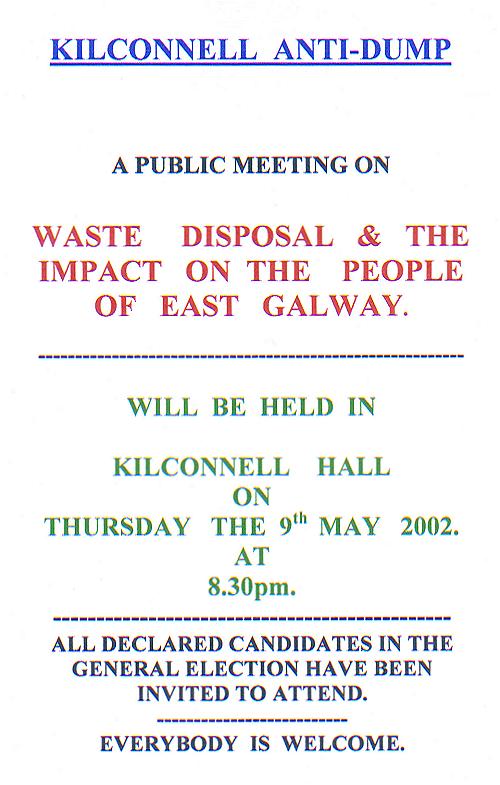| According to fairly recent newspaper reports, a large
company named Celtic Waste have already paid down-payments of £500,000
to a small group of local landowners for the huge rubbish dump they
plan to set up in the Kilconnell area of East Galway: large enough possibly to serve the whole
Province of Connacht (roughly one-quarter the size of Ireland).
The site Celtic Waste plan to build their superdump on almost
touches the Esker
Riada ridge: which, from a human history viewpoint, is thought to
be Ireland's most important natural monument. Clonmacnoise, the
world's first major Christian university, and probably the most
influental as well, is approximately 25 miles to
the east (at the point where the Esker Riada and the River Shannon
intersect).
The general area surrounding the proposed Celtic Waste site near Kilconnell
is unusually rich in ancient monuments, largely because of
the Esker Riada which has been
in use as "An Slí Mór" ("The
Great Road") across the middle of Ireland for thousands of years.
The actual site for the proposed rubbish dump is itself
closely surrounded by a circular group of ancient monuments which have
been formally listed in the "Archaeological Inventory of
County Galway" (ISBN: 0-7076-6179-X). In addition, the lovely ruins of Kilconnell Friary -
amongst the most attractive in Ireland - are just a mile or so to the
east of the proposed Celtic Waste superdump site.
Woodlawn
House is also within a mile or so to the north-west of the site Celtic Waste have
earmarked; and, speculative plans to have this beautiful and historic set of buildings restored
and made into a good quality hotel complex are being severely hampered by the
threat of the Celtic Waste superdump (and the colonies of rats,
flies,
and scavenger birds which are normally a feature of such places). As a
further "turn-off" for potential investors, there is also
the matter of the obnoxious odours that can be expected to waft all
around the nearby area: especially during warm weather.
There are compelling reasons for believing that the successful development
of the Woodlawn House property (which is literally falling
to pieces
at the present time) could have huge long-term benefits for the local
community. One architect's written report
suggests that if nothing is done about it soon, the ongoing
deterioration of the main building will become irreversible within two
years or so.
A very important "Diarmuid and Graine" heritage site is
located just yards from the front door of Woodlawn House - please see
site marked 250 on the map at:
http://homepage.eircom.net/~williamfinnerty/wh/Diarmuid-and-Grainne-1.htm
The word famous Turoe
Stone is just a few miles away: which may have been at the centre
of a vast oppidum (town or settlement) that radiated for miles
outwards from the Turoe area, and, historically, goes right back to
the origins of Celtic Ireland (according to 40 years of research work
carried out by Fr.
Tom O'Connor).
The Dunkellin River rises in the area which Celtic Waste
plan to build their dump in. This river then flows right across East
Galway (for around 25 miles), and enters the Atlantic Ocean (near
Kilcolgan) at the most easterly part of the world famous Galway
Bay: which also happens to be in the same area as the most westerly
point of the Esker Riada ridge. (The earliest people to enter Ireland
through Galway Bay - likely to have been many 1000's of years ago -
would have found in this particular area a ready-made road straight into
the heart of Ireland, together with a plentiful supply of drinking
water from the Dunkellin River for much of the way along the route.)
The Esker Riada runs right through the Parish of Bullaun &
New Inn ("Sarsfield's
Country") and, as it is roughly half-way between Clonmacnoise
and Galway Bay, this 5 mile span of the ridge (which includes the Hill
of Grange) was probably an important resting point from the earliest
times for ancient
travellers.
For several years now, the people of Bullaun & New Inn have
been saddled with the threat of a superdump
being located at either end of their parish: the Celtic Waste one at
the eastern end (near Woodlawn House), and, the Central
Government one at the western end (near Turoe).
The people trying to drive these superdump plans ahead appear to
have NO REGARD for the fact that New Inn has already hosted a
large rubbish dump for a period of 18 years (between 1971 and 1989),
and that nobody seems to know what kind of toxic substances are at present
seeping into the local water supplies: because nobody seems to know
exactly what went into this particular dump during the 18 years it was in use. In addition, and as is plain for all to see, Galway County Council
(who ran the New Inn dump) have left a mile-long string of eye-sores
along this particular section of the Esker Riada: which they first
destroyed (by removing large parts of it for its sand and stones), and then later
dumped rubbish in. |
